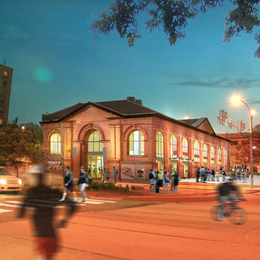
On the northernmost outskirts of Philadelphia’s Old City neighborhood, practically in the shadow of the oversized K’NEX playset known as the Benjamin Franklin Bridge, Nick Stuccio’s “grand experiment” is titillatingly close to revealing itself.
Next month, FringeArts (fringearts.com)—the institution formerly, and somewhat clumsily, known as Philadelphia Live Arts Festival and Philly Fringe—will open the doors to its year-round home for artist performances and complementary operations in a historic fire-service building across from the Race Street Pier. Even though its progress is slightly behind schedule, the building renovations as of late July were “looking spectacular,” according to Stuccio, president and producing director of FringeArts, who lives in Narberth.
Once complete, the 10,000-square-foot waterfront space will host a slate of performers through December, and then march boldly into 2014. The performance aspect, however, is merely the first phase. The building will also include a restaurant and bar, which are expected to open by Valentine’s Day, as well as an outdoor plaza due to be finished a few months later. Stuccio, who founded the left-of-center festival in 1997 after time as a Pennsylvania Ballet dancer, envisions FringeArts’ headquarters as “a place to hang out with friends and meet artists before and after the show, and also have a yummy beer and a cheeseburger.”
“Being a former artist has been helpful and very important in relating to other artists and their ideas,” he says. “I want to be their champion, and I hold them in the highest regard. I can talk their language and it’s been helpful in building great, trusting relationships. I have a passion for now being the person in the ‘back of the house,’ and I get the same high [from programming] as I did from performing.
“When we first started this, there was a bit of a growing underground of people who had an appetite for [alternative art forms],” he continues. “We were lucky, being in the right place at the right time. … Now the culture as a whole is moving a little to the left, and even some of the cultural mainstays, like the orchestra, are beginning to imagine some of their productions in an avant-garde way. There’s a whole burgeoning contemporary art culture.”
Stuccio had been hoping to have the building ready for this year’s festival, which runs from September 5 to 22. The festival will include not only a selection of “Presented Fringe” performances from internationally renowned artists and notables of the Philadelphia arts scene, but also more than 100 independently produced acts from “Neighborhood Fringe” artists. In all, the festival will feature 700-plus performances—dance, theater, comedy, visual art, etc.—at venues such as the Painted Bride Art Center, the 23rd Street Armory, the Suzanne Roberts Theatre and the Arts Bank at the University of the Arts. As with performances from festivals past, this year’s collective lineup is the product of risk-taking artists free of what Stuccio calls “curatorial barriers.”
“The artist’s role is to provoke, make us think and shine a mirror on the culture we live in,” he says. “Like every great city, Philadelphia is known for its SOBs—symphonies, operas and ballets—but we also have a big culture of alternative artists here who are making contemporary art. There’s a real appetite for it.”


